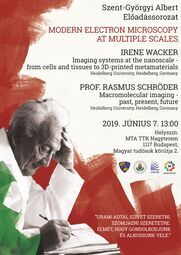Archive for May 2019
Szent-Györgyi Lecture: Modern electron microscopy at multiple scales 2019-05-15
Modern electron microscopy at multiple scales (abstract, picture)
Irene Wacker: Imaging systems at the nanoscale - from cells and tissues to 3D-printed metamaterials
Prof. Rasmus Schröder: Macromolecular imaging - past, present, future
June 7. 2019, 1 p.m., MTA TTK

and Krio-EM mini conference:
László Buday: Complex formation of Tks4 scaffold protein with its binding partners
Scaffold proteins modulate signalling in cells via bringing regulatory proteins or enzymes in close proximity. Based on the structure of Tks4 scaffold protein, it seems to be capable of binding several protein partners. In the project, we wish to determine the 3D structure of Tks4 in complex with its binding partners.
András Szöllősi: Structure of TRPM2 cation channel from Nematostella vectensis
Transient Receptor Potential Melastatin 2 (TRPM2) is a non-selective cation channel important for the immune response, insulin secretion, and body temperature control. TRPM2 is activated by cytosolic Ca2+, phosphatidyl-inositol-4,5-bisphosphate and ADP ribose. Here, we present the ~3 Å resolution electron cryo-microscopic structure of TRPM2 from Nematostella vectensis, 63% similar in sequence to human TRPM2, in the Ca2+-bound closed state.
Bianka Farkas : Using cryo-EM maps to determine protein transmembrane regions
In order to understand transmembrane protein function and to develop novel therapies targeting diseases associated with these proteins, it is crucial to define the localization of transmembrane regions. Experimental data on the boundaries of membrane embedded regions is sparse, but now this information is present in cryo-electron microscopy (cryo-EM) density maps. Therefore, we developed a computational pipeline, which provides the first, atomic resolution experimental data set on transmembrane regions extracted from cryo-EM maps.
Zoltán Gáspári: Interaction networks of postsynaptic proteins
The postsynaptic density (PSD) is a dense protein network capable of dynamic reorganization, playing a key role in the molecular processes of learning and memory. Our aim is to decipher the partners and the interdependence between various interactions of selected PSD proteins by investigating the structure and dynamics of some key proteins and their complexes. We currently primarily use NMR spectroscopy but, depending on the properties of the proteins and complexes, we plan to apply other methods where appropriate.
Zoltán Urbányi: Structural characteritaion of the active pharmaceutical ingredients of biopharmaceuticals
In the case of both novel and biosimilar biopharmaceutical the detailed structural characterization is a regulatory requirement. This characterization can be performed by using an arsenal of different orthogonal methods as X-ray diffraction, NMR, FT-IR, CD, HDX-MS etc. All of these methods have limitation to determine the exact structure of proteins in solvent phase. Cryo-EM may provide a kind of solutions for the problem of correct structural determination and comparison.
András Málnási-Csizmadia: Drug development targeting myosin
